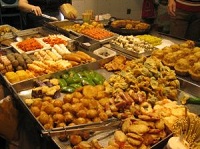Hong Kong offers a wide variety of choices to those who love dining out. From swanky restaurants to tiny street stalls, eating out is a popular pastime here. Hong Kong has been influenced by Eastern and Western cultures and you have the opportunity to sample cuisines from different countries like Japan, Malaysia, Vietnam, India, Europe and America. Since the variety of food available is so vast, here’s a list of five foods you must try when living in Hong Kong.
Tang Yuan
These glutinous rice balls serve as an excellent breakfast food, and also double up as a delicious dessert.They are filled with a black sesame or red bean paste and have a sweet flavor. They could also have ground peanuts added to the paste. These decadent sweet dumplings may be served with ginger syrup or just plain hot water. Tang Yuan is actually a very traditional Chinese dessert and is eaten at family gatherings or on certain holidays. The spherical shape of the dumplings is symbolic of the close bonds between families, signifying a full circle. Tang Yuan may also be kept unfilled. Both filled and unfilled ones use rice flour as the main ingredient. The fillings can also be savory and these Tang Yuan are served in a clear soup broth.
Snake Soup
This ominous-sounding dish is actually a popular winter food in Hong Kong. It is even considered to be a gourmet dish. A Cantonese delicacy, the main ingredients are the meat of at least two different varieties of snakes. The soup tastes slightly sweet as traditional recipes also call for the addition of chrysanthemum leaves and some spices. And for those wondering what snake meat tastes like, it’s somewhat similar to chicken. Many restaurants make use of frozen or chilled snake meat that comes from China. But there are some eateries where you can even select the live snake you would like in your soup. Snake soup is believed to be beneficial for health and Chinese medical practitioners say that it can cure a host of bodily ailments like skin problems and blood circulation disorders.
Yuen Yeung
Yuen Yeung, also called youan yang or yin yeung, can be translated as coffee with tea. This is perfect for those who love both and just don’t want to choose. It is milk tea and coffee combined and served either hot or cold. A popular Hong Kong beverage, it contains three parts coffee and seven parts milk tea. Initially, only the open-air food vendors or dai pai dongs served Yuen Yeung. But today you can find it on many restaurant menus too. The name of the drink is a reference to Mandarin ducks, which are usually seen in pairs and symbolize the attraction between opposites in Chinese culture. Yuen Yeung has grown so much in popularity that Starbucks in Hong Kong has introduced a Yuen Yeung Frapuccino.
Thousand-year egg
Also known as century egg or preserved egg, this delicacy is not for the faint-hearted. The recipe hails from Chinese cuisine and involves the preservation of duck, quail or chicken eggs in a mixture of salt, clay, ash and other substances for duration ranging from a few weeks to many months. During this period, the yolk turns to dark green or grey and emits a sulphurous odor. The whites of the egg break down into a gelatinous brown substance, which may have a salty flavor. Many street vendors serve the eggs whole or slice them up and add them to noodle dishes. They can also be eaten as appetizers when they are wrapped with slices of pickled ginger root.
Bo Lo Bao
Bo Lo Bao or pineapple bun is a Hong Kong invention. They are delightfully soft with a crunchy crust and can be eaten for breakfast or as an evening snack. Despite the name, they do not contain pineapple. It’s just a reference to the crust, which resembles the outer skin of a pineapple. This crust is comprised of eggs, sugar, flour and lard, although there are healthier versions of the recipe. In many Hong Kong restaurants, you can order a ‘buttered pineapple bun’, a bun filled with a piece of butter. Some variants have a filling of custard.

